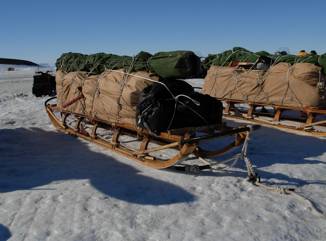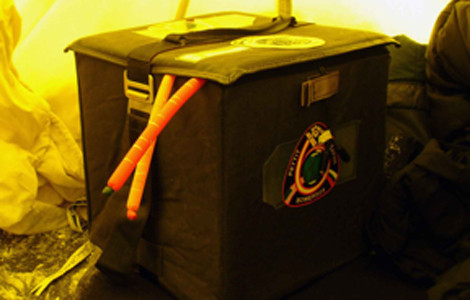Blood and Treasure
And a high-tech box to store it in.
Gold, silk, and spices were tangible treasures from past exploration. The Conquistadors were particularly good at extracting gold from the local inhabitants. Sir Francis Drake, before he acquired the title of “Sir,” brought back enough treasure from his circumnavigation of the globe to provide more than half the income for the British crown for an entire year. The frontiers of space likewise offer treasures won from exploration, treasures that will enrich our lives and enhance our standard of living. These treasures are golden but not gold. They contain secrets about the biochemistry of life, and will allow us to increase our understanding of how life functions. No more silver and gold; from Space Station we have blood, spit, and urine, treasures that contain secrets more valuable than a chest filled with pillaged Aztec gold.
On Space Station, we are human guinea pigs for a wide variety of medical experiments. The weightlessness of space offers a biochemical challenge to our bodies, which develop a host of fascinating maladies such as bone decalcification, cataracts, retina swelling, eye focus shifts, smooth muscle atrophy, fluid imbalance, gross weight loss, cardiovascular degeneration, and more. In spite of these maladies, humans can thrive in space, proving that as a species, we are a hardy lot and can explore places where we were never meant to go.
The microgravity of Space Station allows for yet one more experimental variable, offering an amazing and unique environment in which to study human physiology. Mother Earth throughout time has tormented creatures with every possible variation of environmental parameters. She has tweaked temperatures from hot to cold, pressures from high to low, chemical compositions from reducing to oxidizing and acid to base, and more. She has thrown stones at us from space and spewed out molten rock and ash from within. The layers of rocks are littered with fossils of hapless creatures that could not make the grade, or, through no fault of their own, were simply caught in the wrong epoch of geologic time. The history of life on Earth is the story of species extinction, a fascinating thought for those of us that are still here and can contemplate such a construct.
With all this change, with all this process, throughout all the evolution, the one factor that has been constant for billions of years is the magnitude of Earth’s gravity. Now we can venture off the planet and for the first time in the history of life, vary the influence of gravity by a factor of one million. The fact that we can survive in space is in itself an amazing discovery. We truly are off in a new frontier, one that life has never seen on Earth, and it is on this frontier that physiological secrets can be pried from the people who go there.
As the crew of Space Station, we routinely puncture veins, drool on cotton swabs, and urinate in bags. These samples are processed in centrifuges, sprinkled with preservatives, placed in tubes, and stored in MELFI, better known as “the freezer.” Kept at -98° C, these samples are stored for months before return passage to Earth can be arranged. To ensure safe passage of these treasures through the ride back to Earth, NASA has developed a special cold box that keeps them frozen for several days, ensuring unthawed recovery by ground crews, happy life science researchers, and crew members relieved to know that their bloodletting was not in vain.
The cold boxes themselves are an engineering marvel. They are nearly equal in thermal conductivity to a vacuum dewar (Thermos bottle) with only a fraction of the mass. They are made from truly space-aged materials; aerogel and Mylar. Aerogel is the most gossamer solid material known. Appearing more like solid smoke, aerogel has a density only 10 times greater than that of air (steel has a density 7,000 times greater than air) making it one of the best thermal insulators known, bested only by vacuum. Aerogel is brittle, readily crumbing into dust. To prevent this eventuality, it is placed inside a skin of Mylar (plastic) film. The air is then sucked out, making this structure as rigid as a vacuum-packed bag of coffee (which feels brick-hard until the package is opened). These Mylar-packed aerogel structures can be made into odd shapes, enabling cold boxes to fit in unused pie-shaped spacecraft volumes.
When new technology is developed, other unintended uses often surface. Such was the case for the cold box. Developed for space, it ended up in Antarctica, not for keeping things cold but for keeping them warm. In 2006-2007, I had the good fortune to live in a tent about 200 miles from the South Pole during a scientific expedition to Antarctica as part of a meteorite gathering team called ANSMET (Antarctic Search for Meteorites). The conditions found in Antarctica preserve and concentrate meteorites, a discovery not realized until the early 1970’s. They accumulate on the surface of the blue glacier ice, and because they appear as strongly contrasting black specks from a distance, they can be recognized from afar and gathered like cosmic Easter eggs. For the last 30 years, annual expeditions working during the short Antarctic summers have gathered over 20,000 meteorites. During our six-week stay, we advanced this number by 850.

Our Nansen sledge differed little from those used in the 1880s. The NASA hot box is lashed to it (inside the black bag).
Living in a tent under primitive conditions, the ambient temperature danced around -20° C throughout the continuous daylight of the Antarctic summer day. Including wind chill, the effective temperature was -40° C. At such temperature levels, it does not matter what scale is used. In our tents, the floor temperature stayed at -20° C and the chimney varied from -20° C to +20° C, depending on whether the stove was lit. Any water-based substance became a frozen lump. Most electronic devices refuse to operate under these conditions; from batteries that do not make sparks (lithium-ion batteries do not like to be charged if less than 0° C), LCD displays that give only blank stares, or hard drives that do not turn at the right speed.
The Antarctic hot box in its former life was an engineering test article used to make thermal measurements for the design of the spaceflight units. Having served that purpose, I found it in a dank NASA cabinet, itself in cold storage and seemingly of no further use. Brought out from retirement, this high-tech space cooler found itself strapped to a Nansen sledge, pounding through the Antarctic interior over snow structures known as sastrugi. In a sea of cold, it offered a small oasis of warmth. We also kept our Tabasco sauce and sourdough starter in the hot box, demonstrating the value of having small comforts when living on the frontier.
Thus we behold the new treasure garnered from the frontier of space. Not gold or spices, but knowledge. Knowledge always has value, even if we don’t immediately know or recognize it. The real treasure of new exploration is the larger knowledge base and the expanded imagination we develop from it. In time, all knowledge shows itself to be useful in some way. The fact that today it is difficult to pinpoint the value of space exploration shows that it is truly venturing into terra incognita, unknown territory.
/https://tf-cmsv2-smithsonianmag-media.s3.amazonaws.com/accounts/headshot/Pettit_in_Star_City.JPG)

/https://tf-cmsv2-smithsonianmag-media.s3.amazonaws.com/accounts/headshot/Pettit_in_Star_City.JPG)